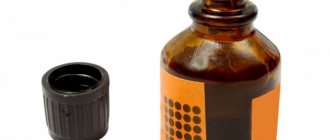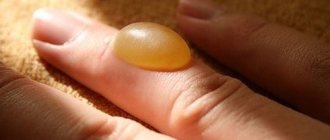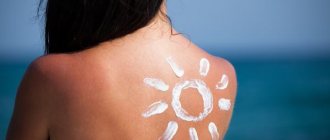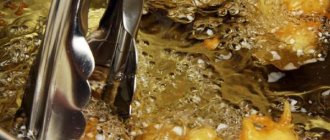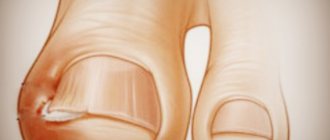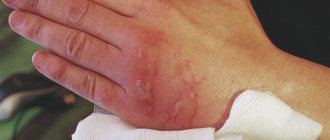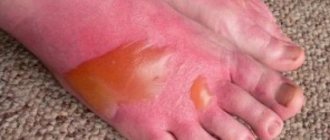H1 CC
Skip to content
- cosmetologist
- Contacts
Home »Foot care
It is not difficult to recognize a water callus that has formed on the heel. It looks like a small bubble (however, calluses come in different sizes) with liquid accumulated inside it. This formation occurs as a result of friction of the skin of the foot and often causes a person to feel pain. And if a callus on your foot bursts, what should you do in such a situation? What measures should be taken first?
After all, when the wound opens, there is a risk of accidentally introducing an infection inside.
It is within your power to prevent these unpleasant consequences if you take all necessary measures.
First aid for a torn callus
- After the incident, eliminate factors that could damage or infect the wound. That is, if the callus breaks, stop applying the skin on the hand.
- Next, you need to carry out disinfection to prevent the inflammatory process. It must be remembered that in case of complications, surgical assistance may be necessary. The problem area is carefully treated with an antiseptic: alcohol, hydrogen peroxide. It is also permissible to use chlorhexedine, iodine, betadine, ethyl or isopropyl alcohol solution as disinfection. If there are areas of skin left near the wound, they should not be removed.
- Then you need to apply a special patch or ointment. To treat torn calluses, the time-tested Levomekol ointment is used. It is inexpensive and has a positive effect. You can make your own ointment from medicinal herbs. The affected area of skin is treated several times a day. With regular care, new skin will appear in 3-4 days.
Important! If there is no improvement, but on the contrary, pus, swelling, chills appear, or the temperature rises, be sure to consult a doctor.
How to treat?
Healing patch
You can cure a burst callus with a special anti-callus plaster. It absorbs excess lymph fluid, does not interfere with the skin’s ability to “breathe,” and promotes rapid healing of the wound. The algorithm for gluing the patch is as follows:
“Healing” patches are available in pharmacies that treat and heal a broken callus.
- carefully cut off dead skin;
- Wipe the sore spot with water and pat dry with a soft towel;
- stick on an anti-callus plaster, which will fall off on its own when the wound heals;
- Persons with diabetes mellitus should consult a specialized physician before treating ruptured dropsy with this method.
Medicines
After the callus is disinfected, you need to apply ointment to it. The pharmacy kiosk offers many different ointments. The most popular of them are presented in the table:
| Name of the drug | Action |
| "Levomekol" | Acts in the fight against microbes, stops inflammatory processes and restores damaged tissues |
| "Sintomycin" | Relieves pain and has an antibacterial effect |
| Salicylic ointment | Disinfects and removes inflammation from the skin |
| Zelenka | Has a disinfectant, antimicrobial and antiseptic effect |
You can use homemade products to prepare a treatment for a broken callus.
Folk recipes
To heal a burst callus, representatives of alternative medicine offer the following natural remedies:
| № | Name | Recipe |
| 1 | Honey ointment | Lubricate the wound with honey warmed to room temperature and wrap it with a bandage. Change the bandage three times a day |
| 2 | Yarrow compress | Chop the plant, place it on a piece of gauze and fix it to the wound. |
| 3 | Celery root lotions | Grind the root and mix with 100 ml of sunflower oil. Apply to the callus and bandage with a sterile bandage |
Treatment for complications and purulent wounds
If the wound is not treated on time, rarely bandaged, kept wet or dirty, an infection may develop on the hands. Which poses a great danger.
Signs of infection:
- throbbing, aching pain;
- swelling of the skin around the wound;
- redness near the problem area more than 2-3 mm;
- temperature above 37°.
Treatment is carried out on important points:
- Remove pus. If pus has formed in the wound, it needs to be cleaned. If the torn callus is covered with a crust, it must be soaked with hydrogen peroxide and carefully removed with a soaked swab.
- Treat the wound every day with peroxide, and if pus appears, clean it.
- Applying a bandage. After disinfection, you need to apply a bandage with a healing agent.
What to do if a callus bursts on your foot
The main reason for the appearance of a water papule is a sudden change in seasonal shoes. The finger rubs due to constant friction of the bare skin in the boots. The bubble causes pain and discomfort. To quickly cure a lump, you need the right approach.
Dry and wet formations may appear on the legs. A corn is a strong thickening of keratinized skin. The callus has an internal root of dead cells that looks like a funnel. Appears mainly in people who are overweight and wear high heels. The entire load falls on the skin of the foot, and a compaction forms.
Symptoms of fluid blisters include swelling, redness, and a white blister with clear contents. If treatment is not treated in a timely manner, the papule bursts and a hard core begins to form.
A type of wet seal is a bloody blister that forms at the location of the vessel. There is blood inside the blade. Such papules take longer to heal than usual. If you open it yourself, there is a high probability of infection getting into the wound.
If a callus on your feet bursts, you should avoid the influence of unfavorable factors:
- Stop wearing tight shoes with high platforms and heels.
- Wear tights and socks without internal seams or designer inserts.
The papule with its contents may tear and crack. Do not attempt to open or tear the surrounding skin down to the meat to prevent infection of the soft tissue. To disinfect the foot, use alcohol, furatsilin solution, and hydrogen peroxide. It is not recommended to keep the damaged area closed; the sole should breathe for faster recovery. It is advisable to wear comfortable boots or shoes to prevent injury. An open papule must be treated constantly. If the skin has broken near the callus on the heel and is coming off, there is no need to rip it off. The heel part is lubricated with salicylic ointment, which dries and cleans the wound of germs.
If pus is discharged, you should seek medical help.
How to remove a wet callus
If the callus on your hands is small and does not cause inconvenience, then it is better not to touch it and cover it with a bactericidal plaster. To treat wet calluses, Compeed medical adhesive plaster is sold. For dry calluses, “Solipod” and “Urgo” are used. The patch can be used on small and not very painful areas. Otherwise, you need to carry out all procedures to treat the problem area.
If the bubble is large, you can rip it off at any time, then it is better to open it yourself. The callus should be laid for the first time 24 hours after its appearance, while the cells of the tire are still viable.
It is important to comply with some conditions:
- Disinfect hands and surfaces of the formation. To do this, you can use an alcohol solution of iodine, as it relieves inflammation.
- It is necessary to take a sharp needle, for example, from a disposable syringe. You can use a pin or a sewing needle, but sterilize it over a fire or soak it in alcohol or iodine for a while.
- Carefully puncture the blister; the puncture itself is made parallel to the palm so as not to touch the skin. Blot the liquid with a sterile cotton swab or bandage.
- Apply antibiotic ointment or traditional medicine presented below.
- Apply a patch, apply a bandage. It should be changed twice a day and removed at night so that the wound can breathe and the healing process occurs faster.
How to quickly cure flayed ones?
If the top layer of the callus is damaged, it is best to wash it with an antiseptic (peroxide or chlorhexidine, these agents cause the least burning sensation), and stick a patch containing acetylsalicylic acid on top. This is a component that has analgesic and anti-inflammatory effects.
What to apply to make it heal faster?
The most suitable remedies for rapid healing of calluses are:
- Salicylic ointment.
- Syntomycin emulsion.
- Levomekol.
- "Compeed" patch.
- Plaster "COSMOS Hydro Active" from HARTMANN PAUL.
Is it possible to apply iodine?
Yes, calluses can be smeared with iodine. It is better not to apply the solution to the skinned area.
The concentration of the product should be minimal to avoid potential burns to the skin, even if it is not damaged. To do this, iodine can be diluted with water in a 1:1 ratio. You need to apply it very carefully, as the product causes a strong burning sensation.
Is it possible to anoint with brilliant green?
Zelenka is less aggressive than iodine. There is no point in applying the product to dry calluses, because it dries out the skin even more.
It is best to use brilliant green to treat wet, unbroken calluses. This will ensure the prevention of secondary infection.
An exposed area of skin should not be lubricated with brilliant green, because, like iodine, it can cause a burn. The dilution ratio of the product with water is the same – 1:1.
How to treat an open one?
First of all, the open callus must be disinfected. Peroxide and chlorhexidine are suitable for this. It is better not to use alcohol, since its use may cause painful sensations on an already damaged area of skin.
You need to let the callus dry a little. Then it is sealed with a bactericidal plaster to speed up healing and prevent the entry of pathogenic bacteria.
Treatment of hard and core calluses
These types of formations on the hands are removed by scraping. To do this, you can use pumice or pre-soak it with any solution to treat the problem area. There are special medications to soften calluses, for example, salicylic acid. Soak a cotton pad in it and apply it for several hours. But you need to be extremely careful not to injure the healthy skin around you. Traditional remedies are also widely used.
When removing a callus, fill the resulting cavity with salicylic acid and an antiseptic, and apply a bandage.
Symptoms of infection
The following signs may indicate that the wound has become infected:
- Redness and slight swelling of the wound and the skin around it. This place hurts both when you touch it and on its own when moving.
- Discharge of pus from the wound, which may be accompanied by blood.
- Increased skin temperature in the area around the wound. With severe infection, an increase in body temperature is possible.
Redness, suppuration, itching, pain are signs of infection entering the body through a burst callus.
If you observe the above symptoms, you should immediately contact a specialized physician for qualified help. Self-medication can aggravate the situation, leading to widespread spread of infection to healthy areas of the skin.
Traditional medicine
- Burdock ointment. To prepare the ointment, you need 75 grams of burdock root, add 200 grams of vegetable oil. Leave for 24 hours, boil for 20 minutes over low heat, strain. Treat the wound with ointment twice a day.
- Swamp cranberry. It has long been a natural antibiotic. Make a paste or compress from the berries. Apply to the wound several times a day.
- Aloe juice. The plant is used not only to treat wounds, but also to soften dry formations. Lotions are made or a cut aloe leaf is adjusted. When using the plant, microbes are destroyed, new cells are regenerated, and the healing process is accelerated.
- Lilac leaves. They have healing properties. Fresh leaves are crushed to a pulp; you can use a blender. Squeeze out the juice and apply the pulp to the painful area two to three times a day. The leaves must be fresh. According to this scheme, you can use the leaves of ordinary grapes.
- Plantain. Famous traditional medicine doctor. You need a few freshly picked leaves, rinse them and simply apply them to the wound, pressing lightly. Change leaves after 5 minutes. A positive result is observed due to the antiseptic qualities of the plant.
Prevention
In order to avoid torn calluses, you need to protect your hands during physical work and sports. Household gloves do not prevent the appearance of calluses, but the risk of tearing them is significantly reduced.
If calluses appear frequently, the body may not have enough vitamin A. It is necessary to compensate for the deficiency by taking medication, or you can increase the consumption of foods containing vitamin A. For the skin, use a cream based on the same vitamin.
Another folk remedy for prevention is the use of calendula pulp. You need to cover your hands with a fresh prepared mixture of flowers several times a month.
How to prevent calluses from falling off and eliminating calluses from the horizontal bar
Of course, it is better to take care of your hands during active physical activity than to get rid of painful consequences later. But if these have already happened, it is necessary to provide first aid in time, take time for treatment, and then the hands will become whole and healthy.
Ways to prevent formations
Treating water callus is much more difficult than preventing its formation. To avoid rubbing dropsy, it is recommended to comply with the following requirements:
- It is advisable to break in new shoes using a special product to soften them,
- use “footprints” so that the heel does not rub,
- Don't put on shoes if your feet are wet.
The problem area should heal in no more than 2-3 weeks. For inflammation that lasts longer, the patient should visit a doctor (dermatologist, surgeon).
A wet callus, if it bursts, causes pain and discomfort to a person, so you should not delay treatment and a visit to the doctor. To prevent the development of a pathological process, if you notice increased friction, stick a piece of adhesive tape on the problem area. It is recommended to select shoes according to your foot size and wear them at the appropriate time according to weather conditions. Compliance with hygiene rules reduces damage to the feet by calluses.
